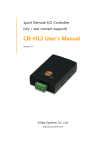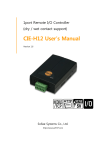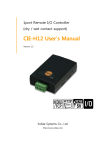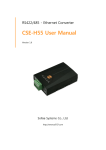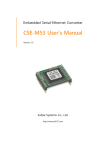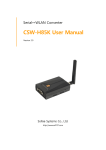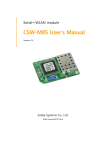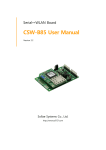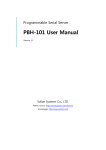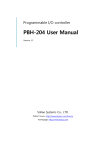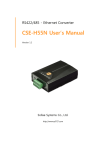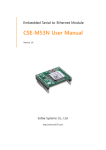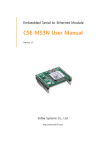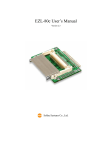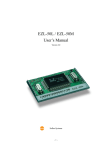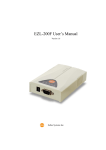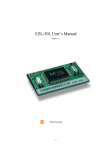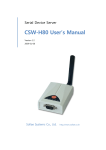Download CIE-H12 User Manual
Transcript
1port Remote I/O Controller (dry / wet contact support) CIE-H12 User Manual Version 2.1 Sollae Systems Co., Ltd. http://www.ezTCP.com CIE-H12 User Manual Ver. 2.1 This symbol, found on your product or on its packaging, indicates that this product should not be treated as household waste when you wish to dispose of it. Instead, it should be handed over to an applicable collection point for the recycling of electrical and electronic equipment. By ensuring this product is disposed of correctly, you will help prevent potential negative consequences to the environment and human health, which could otherwise be caused by inappropriate disposal of this product. The recycling of materials will help to conserve natural resources. For more detailed information about the recycling of this product, please contact your local city office, household waste disposal service or the retail store where you purchased this product. -1- http://www.ezTCP.com CIE-H12 User Manual Ver. 2.1 Contents Contents ............................................................................................................................................- 2 1 Introduction .............................................................................................................................- 5 - 1.1 Introduction .......................................................................................................................................................... - 5 1.2 Features .................................................................................................................................................................. - 5 1.3 Application Examples ....................................................................................................................................... - 6 1.4 Components ......................................................................................................................................................... - 7 1.5 Specification ......................................................................................................................................................... - 7 - 1.5.1 H/W specification ..................................................................................................................................... - 7 1.5.2 S/W specification ...................................................................................................................................... - 7 1.6 Interface ................................................................................................................................................................. - 8 - 1.6.1 Input Ports ................................................................................................................................................... - 8 1.6.2 Output Ports ............................................................................................................................................ - 10 1.6.3 Ethernet Interface .................................................................................................................................. - 11 1.6.4 Power ........................................................................................................................................................... - 11 1.6.5 System LED ............................................................................................................................................... - 12 1.6.6 ISP Switch .................................................................................................................................................. - 12 2 Installation and Test ............................................................................................................ - 13 - 2.1 Installation .......................................................................................................................................................... - 13 - 2.1.1 Setting Network Aera .......................................................................................................................... - 13 2.2 Test operation ................................................................................................................................................... - 15 - 2.2.1 Modbus/TCP Test ................................................................................................................................... - 15 2.2.2 HTTP Test with a WEB browser ....................................................................................................... - 17 3 Configuration ....................................................................................................................... - 18 - 3.1 Configuration with ezManager ................................................................................................................. - 18 - 3.1.1 Configuration via LAN ......................................................................................................................... - 18 4 Operation Modes ................................................................................................................ - 19 - 4.1 What is the Operation Mode? .................................................................................................................. - 19 4.2 How to change the mode to another .................................................................................................. - 19 4.3 Comparison of the each mode ................................................................................................................ - 20 4.4 Normal Mode ................................................................................................................................................... - 20 4.5 ISP mode............................................................................................................................................................. - 20 - 4.5.1 Upgrading Firmware............................................................................................................................. - 20 4.5.2 Upgrading HTML ................................................................................................................................... - 20 -2- http://www.ezTCP.com CIE-H12 User Manual Ver. 2.1 4.5.3 Revoking Serurity Options................................................................................................................. - 20 5 Methods for I/O control .................................................................................................... - 21 - 5.1 MODBUS/TCP ................................................................................................................................................... - 21 - 5.1.1 Related Parameters ............................................................................................................................... - 21 5.1.2 Modbus/TCP Slave Mode .................................................................................................................. - 22 5.1.3 Modbus/TCP Master Mode ............................................................................................................... - 22 5.1.4 TCP Connection Modes ...................................................................................................................... - 23 5.1.5 Initial Output Value ............................................................................................................................... - 23 5.1.6 Write Pulse ................................................................................................................................................ - 23 5.2 Macro Mode...................................................................................................................................................... - 24 - 5.2.1 Operator..................................................................................................................................................... - 24 5.2.2 Operand ..................................................................................................................................................... - 24 5.2.3 An Example of Equations ................................................................................................................... - 25 5.3 Monitoring and controlling on Web (HTTP) ...................................................................................... - 26 - 5.3.1 Changing port number for HTTP ................................................................................................... - 26 5.3.2 Uploading Users’ Webpage .............................................................................................................. - 27 6 System Management .......................................................................................................... - 28 - 6.1 Upgrading Firmware ...................................................................................................................................... - 28 - 6.1.1 Firmware .................................................................................................................................................... - 28 6.1.2 Processes ................................................................................................................................................... - 28 6.2 Changing Homepage .................................................................................................................................... - 30 - 6.2.1 Webpage ................................................................................................................................................... - 30 6.2.2 Processes ................................................................................................................................................... - 30 6.3 Status Monitoring ........................................................................................................................................... - 33 - 6.3.1 Using TELNET .......................................................................................................................................... - 33 6.3.2 Checking status by ezManager ....................................................................................................... - 35 7 Additional Functions ........................................................................................................... - 37 - 7.1 Security ................................................................................................................................................................ - 37 - 7.1.1 Restriction of Access (ezTCP Firewall) .......................................................................................... - 37 7.1.2 Setting Password .................................................................................................................................... - 37 7.2 Option Tab Functions .................................................................................................................................... - 38 - 7.2.1 Notify IP Change ................................................................................................................................... - 38 7.2.2 Debugging Message ............................................................................................................................ - 39 7.3 I/O Tab Functions ............................................................................................................................................ - 41 - 7.3.1 Notify Input or Output Port Change............................................................................................ - 41 7.3.2 Valid Time.................................................................................................................................................. - 43 -3- http://www.ezTCP.com CIE-H12 User Manual Ver. 2.1 7.3.3 Delay ............................................................................................................................................................ - 43 8 Self-Test in Trouble ............................................................................................................. - 44 - 8.1 Searching problem with ezManager ...................................................................................................... - 44 8.2 Connection Problem over Modbus/TCP .............................................................................................. - 45 8.3 Communication Problem over Modbus/TCP ..................................................................................... - 46 9 Related material................................................................................................................... - 47 - 9.1 Technical Documents .................................................................................................................................... - 47 9.2 Smart phone application ............................................................................................................................. - 47 10 Technical Support and Warranty ...................................................................................... - 48 - 10.1 Technical Support ........................................................................................................................................... - 48 10.2 Warranty .............................................................................................................................................................. - 48 - 10.2.1 Refund ......................................................................................................................................................... - 48 10.2.2 Free Repair Services ............................................................................................................................. - 48 10.2.3 Charged Repair Services..................................................................................................................... - 48 11 Precaution and Exemption from Liability ....................................................................... - 49 - 11.1 Precaution........................................................................................................................................................... - 49 11.2 Exemption from Liability .............................................................................................................................. - 50 - 11.2.1 English version ........................................................................................................................................ - 50 11.2.2 French version ......................................................................................................................................... - 50 12 History ................................................................................................................................... - 53 - -4- http://www.ezTCP.com CIE-H12 User Manual Ver. 2.1 Introduction 1 1.1 Introduction In the era of Ubiquitous Environment, many kinds of systems which use sensors like temperature, humidity or pressure and controlling the power of remote devices have been developing. CIE-H12 monitors those sensors and controls the remote devices. It detects digital inputs from the sensors’ outputs and controls the relay outputs. HTTP, Modbus/TCP and Macro mode can be used for these functions. CIE-H12 has two input ports and one output port. One of the input ports is a drycontact type and the other one is wet-contact. Thus, you are allowed to use it under both types of systems. 1.2 Features Remote I/O controller 2 Digital Input ports (Dry contact 1 port, Wet contact 1 port) 1 Digital Output Port (Relay interface) Supports Modbus/TCP and HTTP Stored Web server for simple management (custom web page) MACRO (stand-alone operation supports simple logical expressions) Easy configuration program (ezManager) -5- http://www.ezTCP.com CIE-H12 User Manual Ver. 2.1 1.3 Application Examples remote I/O device server Figure 1-1 remote I/O device server Internet Switch Figure 1-2 internet switch Macro mode Figure 1-3 macro mode -6- http://www.ezTCP.com CIE-H12 User Manual Ver. 2.1 1.4 Components CIE-H12 5V Power Adapter (optional) 1.5 Specification 1.5.1 H/W specification Power Input Power DC 5V (±10%) Current Consumption 305mA typical Size 96mm x 57mm x 24mm Weight Approximately 68g Interfaces Digital Input 2 ports with photo couplers (2 input types) Digital Output 1 port with relays Network RJ45 Ethernet 10Base-T or 100Base-TX (Auto-Sensing) Network Auto MDI/MDIX(Cable Auto-sensing) Temperature Operate: 0 ~ 70℃ / Storage: -40 ~ 85℃ Certification CE, KC Environment Follows Europe RoHS Directive Table 1-1 H/W specification 1.5.2 S/W specification TCP, UDP, IP, ICMP, ARP, DHCP, DNS lookup, DDNS, Protocol Modbus/TCP, HTTP, SMTP Diagnose Online Debugging Function Operation Normal Normal communication mode mode ISP F/W upgrade Communication Mode Programs I/O server Modbus/TCP – Slave/Master, Passive/Active Web Browser(HTTP), Macro(Stand-alone) ezManager Configuration program via LAN ModMap Modbus/TCP Application for Windows Table 1-2 S/W specification -7- http://www.ezTCP.com CIE-H12 User Manual Ver. 2.1 1.6 Interface 1.6.1 Input Ports CIE-H12 has two input ports and the each has different type with the other. The one is a “DRY CONTACT” type and the other one is a “WET CONTACT.” Figure 1-4 input ports (the front view) In the front panel, the DRY IN(0) port is the dry contact type and the WET IN(1) port is the wet contact type. The switch input type (Dry contact) The first input port is a dry contact type so you can give the input signal by a switch. Basically, this port is the same with the port WET IN(1) but has additional part for dry contact. Just use a switch for giving signal to this port. Figure 1-5 the dry contact input port -8- http://www.ezTCP.com CIE-H12 User Manual Ver. 2.1 The voltage input type (Wet contact) Figure 1-6 the wet contact input port You can give a DC voltage to input signal to this port. This port is isolated by photocouplers and you don’t have to care about the polarity. The circuit diagram of the input port is shown in the figure below. Figure 1-7 a circuit diagram of the input port The voltage specification of the input port is as follows: Over 1.8V H 1 Under 1.2V L 0 Max. Input Voltage DC 24V Polarity Auto Polarity Table 1-3 the voltage specification of the input ports Use a (-) shaped screwdriver to connect it with users’ devices since the output ports are interfaced with a 3.5mm terminal block, -9- http://www.ezTCP.com CIE-H12 User Manual Ver. 2.1 1.6.2 Output Ports Figure 1-8 the output port (the front view) The port 5 and 6 (OUTPUT) is output port and this port is interfaced with a relay (Normal Open) as shown below. Figure 1-9 a circuit diagram of the output port The output port operates as in the following Value Relay contact 0 OFF (open) 1 ON (short) Table 1-4 values of the output port The allowed output ports’ electrical current of voltage conditions are as in the following: Voltage Condition Allowed current DC28V 5A Table 1-5 voltage conditions of the output port Use a (-) shaped screwdriver to connect it with users’ devices since the output ports are interfaced with a 3.5mm terminal block, CIE-H12 is most appropriate for switching devices in lower voltage conditions than that. Or High capacity relay is recommended. - 10 - http://www.ezTCP.com CIE-H12 User Manual Ver. 2.1 1.6.3 Ethernet Interface An RJ45 connector is for the network interface of CIE-H12. You can use a UTP cable. It automatically senses 10Mbits or 100Mbits Ethernet. It also provides auto MDI/MDIX function that can automatically sense a 1:1 cable or cross over cable. Each Ethernet device has its own hardware address (MAC address). CIE-H12 is shipped to the market with the hardware address set in the factory. Figure 1-10 the RJ45 connector 1.6.4 Power DC 5V is used for the power. The specification of the power jack is as following: Figure 1-11 the power specification - 11 - http://www.ezTCP.com CIE-H12 User Manual Ver. 2.1 1.6.5 System LED CIE-H12 has 2 LEDs on RJ45 and the current system status LEDs for out port and input ports. Each LED represents the following status: place name color LED status description blinks in assigned an IP address every second blinks 4 STS Yellow times at without being assigned an IP address by DHCP once RJ45 On establishing a TCP connection Off operating for the ISP mode On establishing a connection on a network blinks transferring or receiving network data LINK Green Front DI Yellow On when input ports’ signal is ON panel DO Green On when the output port’s signal is ON Table 1-6 status of the system LED 1.6.6 ISP Switch There is an ISP switch located on the side of the product. This button is for changing the mode to the ISP mode. If you press it over a second or supply power while pressing it, CIEH12 will be operated as the ISP mode. In this mode, you can download the firmware file or HTML files. Figure 1-12 ISP switch In the ISP mode, you are allowed to reset a password or cancel access restriction. Use these modes when you are faced with the problems. - 12 - http://www.ezTCP.com CIE-H12 User Manual Ver. 2.1 2 Installation and Test 2.1 Installation In this section, we explain the way of CIE-H12 operation through a test. Basically, its input and output ports are independently used. Thus, you can use either the input ports only for monitoring or the output ports only for control. However, you can also correlatively use those ports by using the MACRO mode on the output ports. Before testing CIE-H12, you should connect the Ethernet port to a PC. It will be no problem if the Ethernet connection is established through network hubs. Figure 2-1 the connection between CIE-H12 and a PC 2.1.1 Setting Network Aera This step is for setting both CIE-H12 and your PC to be located on the same network to establish a TCP connection. Setting of the PC Add or change the IP address of the network adapter on your PC. Click [Windows Control Panel] >> [Network Connections] and right click of your mouse to get into [Properties of the Network Adapter], then you will see the properties of [Internet Protocol (TCP/IP)]. Press the [Advanced Menu] button and add an IP Address as shown below. Figure 2-2 adding / changing an IP address - 13 - http://www.ezTCP.com CIE-H12 User Manual Ver. 2.1 Setting of CIE-H12 ezManager is the management tool for configuration of CIE-H12. This application is only for MS Windows and this is comfortable to use because it does not need installation process. First, search your CIE-H12 via network. All the values of parameters are set to the default values in the factory. To apply it to your system, proper values should be set via ezManager. Default values of some major parameters are listed on the table below. To do the following simple test, keep these values during the test. Parameters Network Option I/O Port Values Local IP Address 10.1.0.1 Subnet Mask 255.0.0.0 Telnet Checked IP Address Search Checked Web (HTTP) Checked Web (HTTP) Port 80 Modbus/TCP Checked Master/Slave Slave Connection Mode Passive Connection Multiple Connection 1 Local Port 502 Table 2-1 default values of some major parameters You can download the latest version of ezManager on the [Download] >> [Utility] page on our website. - 14 - http://www.ezTCP.com CIE-H12 User Manual Ver. 2.1 2.2 Test operation 2.2.1 Modbus/TCP Test This is for checking the operation of Input and output ports of CIE-H12 via Modbus/TCP. In this instruction, offered Modbus/TCP test program was used. Run ezManager. Then, you can see the window as shown below. Figure 2-3 Modbus/TCP test program of the ezManager ① Search connected CIE-H12 with [Search All] button. ② Select a MAC address of searched product on the [search result]. ③ Check the [Advanced Menu] option. ④ Press the [Modbus/TCP] button. ⑤ The test program will appear on the right side of the ezManager In the case of using previous versions of ezManager than 3.1F the test program is shown automatically when you success in searching the product. - 15 - http://www.ezTCP.com CIE-H12 User Manual Ver. 2.1 Modbus/TCP test Figure 2-4 Modbus/TCP test ① Input the IP address of CIE-H12 ② Input the local port for Modbus/TCP of CIE-H12 In a local area network, ① and ② steps can be omitted. ③ Try to connect by pressing [Connect] button ④ Then, check if the input LEDs are turned on or off with signal input ⑤ Check if the output LED is turned on or off with clicking the LEDs ⑥ Click the [Disconnect] button after the test is completed - 16 - http://www.ezTCP.com CIE-H12 User Manual Ver. 2.1 2.2.2 HTTP Test with a WEB browser This is for testing the operation of Input and output ports of CIE-H12 via HTTP. The test was implemented on a WEB browser. You can use WEB browsers such as MS Internet Explorer, Google Chrome and Mozilla Firefox. Figure 2-5 HTTP test ① Input the IP address of your CIE-H12 on the address field (Ex: 10.1.0.1). ② Check if the input LEDs are turned on or off with HIGH signal. ③ Check if the output LED is turned on or off with clicking the each of LEDs. ④ Press the [Read] button to update the status. The way to control output ports manually Parameter Value Example On/Off Pulse o0 (Lower case) p0 (Lower case) ON OFF Time (ms) 1 0 1~10000 http://10.1.0.1/index.html?o0=1 http://10.1.0.1/index.html?p0=1000 Table 2-2 The way to control output ports manually - 17 - http://www.ezTCP.com CIE-H12 User Manual Ver. 2.1 3 Configuration 3.1 Configuration with ezManager Figure 3-1 initial appearance of ezManager 3.1.1 Configuration via LAN Checklists Make sure of the connection between your PC and CIE-H12 via Ethernet. If they are in the same network, [MAC Address search] button can be used. Otherwise, only [IP Address search] is allowed to use. Procedures Figure 3-2 procedures for configuration via LAN - 18 - http://www.ezTCP.com CIE-H12 User Manual Ver. 2.1 4 Operation Modes 4.1 What is the Operation Mode? Each of two operation modes are designed for specific purposes, and those are as follows: Normal mode This mode is for normal data communication and has 2 communication modes. Configuring parameters is also available in this mode. ISP mode This mode is for upgrading firmware and HTML files. In addition, you can set environmental parameters even though the security options are activated. You can also reset the security options. 4.2 How to change the mode to another Figure 4-1 how to initiate each operation mode - 19 - http://www.ezTCP.com CIE-H12 User Manual Ver. 2.1 4.3 Comparison of the each mode The following table shows summaries of each mode. Name Normal ISP Entering Supply the power. Supply the power with pressing the ISP button or press the ISP button over 1 sec in other modes. Table 4-1 comparison of the each mode 4.4 Normal Mode In normal mode, there are 3 types of ways to monitor and control I/O. Types Modbus/TCP Description Control and monitor the I/O of CIE-H12 via Modbus/TCP. It supports both master and slave mode. Users can automatically control the output ports by setting MACRO Macro using some basic formula of Boolean Algebra. Users can not control the output ports through HTTP or Modbus/TCP. WEB(HTTP) Users can monitor and control CIE-H12 via HTTP Table 4-2 digital I/O control types 4.5 ISP mode 4.5.1 Upgrading Firmware ISP mode is for upgrading firmware. Upgrading Firmware is implemented by ezManager. For more details about this, please refer to the clause 6.1. 4.5.2 Upgrading HTML ISP mode can also upgrade HTML files. For more details about this, please refer to the clause 6.2. 4.5.3 Revoking Serurity Options In the ISP mode, you can revoke all of these options like the serial configuration mode. When you forget the password, enter this mode to change or delete it. - 20 - http://www.ezTCP.com CIE-H12 User Manual Ver. 2.1 5 Methods for I/O control 5.1 MODBUS/TCP CIE-H12 supports Modbus/TCP. By using this protocol, it remotely monitors and controls I/O devices. To use this method, your application should support this protocol. 5.1.1 Related Parameters Parameters Modbus/TCP Slave Master Poll Interval Unit ID Input Port Base Address Output Port Base Address Descriptions Using Modbus/TCP for controlling I/O ports of CIE-H12. The slave responses by queries from the Master The Master sends queries to the slaves the period for sending queries (Unit: ms, Minimum value: 10) ID for identifying the device or the pair of devices. Initial address of the input ports Initial address of the output ports Passive Connection waiting for accepting a Modbus/TCP connection Active Connection requesting a Modbus/TCP connection Multiple Connection Control Method of (FC XX) Control Method of (AND/OR) The numbers for multiple Modbus/TCP connections. Control method for the output ports of the slave (Single / Multiple) Control method for the output ports of the master (AND / OR) Peer Address Peer’s IP address when CIE-H12 performs active connections Peer Port Peer’s local port when CIE-H12 performs active connections Local Port CIE-H12’s local port when CIE-H12 performs passive mode. Input Change A function for immediate notification with changing the IP Notification Initialize the output port state address. The Output port will be changed to the [Initial State] when Modbus/TCP is disconnected. (Upper version 1.5A) Macro Applying macro function on the output port Initial State Output port value when CIE-H12 boots up. Table 5-1 Related Parameters We do not recommend changing the [Input Port Base Address] and [Output Port Base Address] unless you need to. - 21 - http://www.ezTCP.com CIE-H12 User Manual Ver. 2.1 5.1.2 Modbus/TCP Slave Mode According to the standard Modbus/TCP, users can use a Modbus/TCP manager to control and monitor their I/O devices. You can set CIE-H12 to the [Slave] item to [Slave] mode. The [Passive] connection is recommended in this mode and the [Peer Port] should be 502. Modbus/TCP Mode Slave TCP Connection Passive TCP Port 502 Table 5-2 values for standard Modbus/TCP Configure the proper values of [Unit ID], [Input Port Base Address], and [Output Port Base Address]. 5.1.3 Modbus/TCP Master Mode In this mode, CIE-H12 operates as a Modbus/TCP master. As a master CIE-H12 transmits its input information to the salve and outputs the slave’s input value to its output port after reading the value periodically. At this time, CIE-H12 controls the output ports with not only bit unit (individually) but also word unit (at once) FC 16(Multiple ports) CIE-H12 controls the output ports and monitors the input ports of slaves with WORD unit by FC16 (write multiple registers) and FC 03 (read holding registers) FC 05(Single port) CIE-H12 controls the output ports and monitors the input ports of slaves with BIT unit by FC05 (write single coil) and FC02 (read discrete inputs). - 22 - http://www.ezTCP.com CIE-H12 User Manual Ver. 2.1 5.1.4 TCP Connection Modes In the standard of Modbus TCP, the master program makes a connection to the slave using port number 502. However, sometimes Modbus/TCP devices try connecting to the master actively. For this case, CIE-H12 supports the active connection mode. - Standard Modbus/TCP. The - Remote host connects to CIE-H12. passive - Port number that is used for communication must be designated. connection - Depending on the setting of multiple connections, up to 8 hosts can be connected. The active connection - CIE-H12 tries to establish a connection to the remote host. - The IP address (or host name) and port number of the remote host is required. Table 5-3 the passive / active connection 5.1.5 Initial Output Value The initial value of CIE-H12’s output port can be configured. The output ports are set to ON or OFF according to the value of [Initial State] at the boot time. 5.1.6 Write Pulse By using the function code 105, you can give the signal of pulse type to the output ports. This means the output signal is kept during the specific time configured by users. Refer to the document [Modbus/TCP of ezTCP] on our website for details. - 23 - http://www.ezTCP.com CIE-H12 User Manual Ver. 2.1 5.2 Macro Mode This mode lets users set the values of the output ports with simple macros. Since CIE- H12 reflects the values according to the macro expressions which are configured by users in advance, it is useful to make a specific device operate automatically using signals from various sensors. Check [Macro] options on ezManager to activate this mode. While using the Macro mode, users can not control the output ports through HTTP or Modbus/TCP. 5.2.1 Operator The algorithm used in the Macro mode is Boolean algebra. In this case, the AND, OR, NOT are used as operators. Parenthesis may also be used. The operators are executed in order of precedence: parenthesis > NOT > AND > OR. Each operator is represented by the following symbols. Name Sign Description Since calculations within the parenthesis have the Parenthesis ( ) highest priority, they will be calculated first. Nested parentheses are allowed. An operand that follows a NOT operator is NOT / toggled. (If an operand is 0, it will be changed to 1. If it is 1, it will be changed to 0.) If both operand values surrounding an AND AND * operator are 1, the result value will be 1. But if otherwise, the result will be 0. If both operand values surrounding an OR OR + operator are 0, the result value will be 0. But if otherwise, the result will be 1. Table 5-4 the operators 5.2.2 Operand Operands used in macro mode are each input port. Each input port is designated with i0 and i1 symbol based on their sequence. Since capital letters are not recognized, they can also be written as I0 and I1. The output ports could not be used as an operand. - 24 - http://www.ezTCP.com CIE-H12 User Manual Ver. 2.1 5.2.3 An Example of Equations Here are two examples. In the expressions, spaces between the two operands will be ignored. Input Port Equations Do0-(A) i0 + i1 Do0-(B) /(i0 * i1) Description Perform bit OR i0 and i1 Perform bit AND i0 and i1. Then, toggle the result Table 5-5 an example of equation The following is the output values coming out as a result of expressions of input values. Input ports Output port i0 i1 Do0-(A) Do0-(B) 0 0 0 1 0 1 1 1 1 0 1 1 1 1 1 0 Table 5-6 the logic table of the table 5-5 - 25 - http://www.ezTCP.com CIE-H12 User Manual Ver. 2.1 5.3 Monitoring and controlling on Web (HTTP) After starting the web browser, type CIE-H12’s IP address after typing http:// in the address bar to connect to CIE-H12. If a password for CIE-H12 is set, the following window will be popped up. Figure 5-1 authentication with a password ① [User name] is not required. Leave blank or put a random name. ② [Password] should be the same with a password which is set through the ezManager. 5.3.1 Changing port number for HTTP In case you cannot use the port number 80(default port number for HTTP) because the ISP (Internet Service Provider) blocks the port, you can change that port number. Figure 5-2 changing port number for HTTP ① Input a port number to the [Web(HTTP) Port] text box. ② Input the IP address of CIE-H12 along with the changed port number and “http://” - 26 - http://www.ezTCP.com CIE-H12 User Manual Ver. 2.1 5.3.2 Uploading Users’ Webpage This function is available to anyone who can make HTML files. If you get some simple syntax, it is possible to monitor and control the I/O ports with your webpage made by yourself. Upgrading HTML files CIE-H12 has a default webpage when it is manufactured in the factory. For advanced users, we have been offering some examples (sample web pages) based on various technologies such as CSS and J query. Figure 5-3 examples of webpage ① Default image based / advanced CSS / Jquery ② Text based - 27 - http://www.ezTCP.com CIE-H12 User Manual Ver. 2.1 6 System Management 6.1 Upgrading Firmware 6.1.1 Firmware Firmware is a type of software for operation of CIE-H12. If it is needed to add function or fix bugs, the firmware will be modified and released. We recommend that users keep using the latest released firmware. 6.1.2 Processes Downloading the latest released firmware Download the newest firmware file. We update our homepage when a new firmware is released. You can find it on our website. Entering ISP mode Enter ISP mode to download firmware file to CIE-H12. Run a TFTP client and ready to send the F/W file Run a TFTP client program. ezManager is equipped with the client program. Click the [Change F/W / HTML] button. Figure 6-1 running TFTP client ① Check the [Advanced Menu] check box ② Click the [Change F/W / HTML] button to run TFTP client ③ Select the [Change Firmware] radio button ④ Input the IP address of CIE-H12 to the [Local IP Address] text box ⑤ Press the [Open Files] button and choose the firmware file - 28 - http://www.ezTCP.com CIE-H12 User Manual Ver. 2.1 Checking firmware file and Sending Figure 6-2 sending firmware file ① Check if the name and path of the firmware file are correct ② Click the [Send] button ③ Confirm the completed message - 29 - http://www.ezTCP.com CIE-H12 User Manual Ver. 2.1 6.2 Changing Homepage 6.2.1 Webpage CIE-H12 comes preloaded with a webpage to facilitate control and monitoring through HTTP. 6.2.2 Processes Making Users‘ homepage or Downloading sample files Make your own homepage file or use sample homepage files freely available to download at our web site. Entering ISP mode Enter ISP mode to send HTML files to CIE-H12. Writing Web(HTTP) port number and selecting size of Web(HTTP) Figure 6-3 Web Basic Settings 80KB or 96KB for the Size of Web(HTTP) is allowed. - 30 - http://www.ezTCP.com CIE-H12 User Manual Ver. 2.1 Running a TFTP client and ready to send the HTML files Run a TFTP client program. ezManager is equipped with the client program. Click the [Change F/W / HTML] button. Figure 6-4 running TFTP client ① Check the [Advanced Menu] check box ② Click the [Change F/W / HTML] button to run TFTP client ③ Select the [Change HTML] radio button ④ Input the IP address of CIE-H12 to the [Local IP Address] text box ⑤ Press the [Open Firmware / HTML] button and choose the HTML file - 31 - http://www.ezTCP.com CIE-H12 User Manual Ver. 2.1 Checking files and Sending Figure 6-5 sending firmware file ① Check if the name and path of the html file including all images are correct ② Click the [Send] button ③ Confirm the completed message - 32 - http://www.ezTCP.com CIE-H12 User Manual Ver. 2.1 6.3 Status Monitoring 6.3.1 Using TELNET Once the [TELNET] option is activated, users can remotely log in to CIE-H12. If a password is set, users should input the password. After that, messages from CIE-H12 appear as shown in the figure below. Figure 6-6 log in to CIE-H12 on TELNET You can check multiple states with the following commands. command st sc option description usage net Network Status lsh>st net uptime System Uptime lsh>st uptime [OP1][OP2] Session Control lsh>sc com1 close Table 6-1 Commands for checking states - 33 - http://www.ezTCP.com CIE-H12 User Manual Ver. 2.1 st net “st net” command displays the current network states of all sessions. Figure 6-7 “st net” command st uptime “st uptime” command shows amount of time since CIE-H12 has booted up. Figure 6-8 “st uptime” command sc “sc” command is used when users close a session. [OP1] means the name of session, and [OP2] should be “CLOSE”. Figure 6-9 “sc” command Lower-case letters are only allowed to use “sc” command. - 34 - http://www.ezTCP.com CIE-H12 User Manual Ver. 2.1 6.3.2 Checking status by ezManager Status of CIE-H12 can be monitored by [Status] button on ezManager. By using the [Refresh Every 1 Second] option in the status window, the status is automatically updated in every second. Figure 6-10 status window of ezManager FIRMWARE VERSION The name of model and the version of firmware are displayed here. SYSTEM UPTIME Operating time of CIE-H12 is displayed since it boots up. IP4 NETWORK INFORMATION All information about related items with IP Address including the MAC address is shown here. It works even if the IP address is assigned from DHCP. - 35 - http://www.ezTCP.com CIE-H12 User Manual Ver. 2.1 TCP STATE TCP status of each port is shown in this section. message description LISTEN waiting for requests of a TCP connection CLOSE a TCP connection is closed SYN_SENT ESTABLISHED N/A send “SYN” segment to make a TCP connection When a TCP connection is established Not Available Table 6-2 TCP STATE I/O PORT STATUS This represents I/O ports’ status. ‘1’ means HIGH(ON) and ‘0’ means LOW(OFF). ARP TABLE This part shows ARP table on CIE-H12. When a TCP connection is established or UDP data communication is performed, the information of IP and MAC address is automatically stored in the ARP table. This information is held for 1 minute. If there is no data communication for 1 minute, the information will be removed. Notify Ports Change (IOTRAP STATE) This part shows E-mail address what you entered, when you use the function [Notify Input or Output Port Change]. TCP/IP Connection In this section, the same information with TCP STATE is displayed with IP address and port number. A difference is that users can terminate a TCP connection. When right click on a session, a small pop-up window is created. Password This text box is activated when CIE-H12 has a password. If users want to close the TCP connection, this password has to be correctly filled. Refresh Every 1 Second. If this option is checked, ezManager sends query in every second. - 36 - http://www.ezTCP.com CIE-H12 User Manual Ver. 2.1 7 Additional Functions 7.1 Security 7.1.1 Restriction of Access (ezTCP Firewall) On the [Option] tab of ezManager, users can set restriction of access function with filtering MAC and IP address. Allowed MAC Address If this option has a value of MAC address, the device which has the MAC address is only permitted to access. Allowed IP Address This is to define hosts with IP address or range of IP address allowed to access. The range is defined by multiplying [IP address] and [Network Mask] in bit unit. Examples IP address network mask allowed IP address range 10.1.0.1 255.0.0.0 10.1.0.1 ∼ 10.255.255.254 10.1.0.1 255.255.255.0 10.1.0.1 ∼ 10.1.0.254 192.168.1.4 255.255.255.255 192.168.1.4 Table 7-1 examples of defining allowed IP range Apply to ezManager [Apply to ezManager] is for applying above two restrictions to ezManager functions like [Search], [Read], [Write], etc. 7.1.2 Setting Password A password can be used to protect CIE-H12 from TELNET login or changing environmental parameters by hosts who are not designated. The maximum length is 8 bytes of Alphabet or number. When you want to revoke all of these restrictions, change the mode of CIE-H12 to the ISP mode. All restrictions are removable and communication with ezManager is revoked in the ISP mode. - 37 - http://www.ezTCP.com CIE-H12 User Manual Ver. 2.1 7.2 Option Tab Functions 7.2.1 Notify IP Change CIE-H12 can be a TCP server even though it is assigned the IP address automatically. Using [Notify IP Change] function, it sends its IP address with the host name to the specific server. There are 3 types of functions provided: DDNS, TCP and UDP. Dynamic Domain Name Service (DDNS) CIE-H12 supports DDNS function offered by DynDNS to manage its changed IP address as a host name. Therefore, you have to make an account and create host names on the website of DynDNS before use this. All about service usage of an account could be changed according to the policy of DynDNS. Homepage of DynDNS: http://dyn.com/dns/ Figure 7-1 setting DDNS ① Select the [DDNS (dyndns.org)] item. ② 40,320 is a fixed value. ③ Input the ID of DDNS account. ④ Input the password of the account. ⑤ Input one of the host names which you created on your account. TCP/UDP In case you have an own server and want to manage the information about changed IP addresses, you are allowed to use TCP/UDP for using this option. The [Data Type] can be selected as ASCII or hexadecimal, and the [Interval] is available on configuration. Refer to the document [Notify IP Change] on our website for details. - 38 - http://www.ezTCP.com CIE-H12 User Manual Ver. 2.1 7.2.2 Debugging Message By using [Debugging] option, users can receive debugging messages from CIE-H12 on the network. When you are facing a problem about the TCP connection or data communication, use this function and send us the stored file. We can use it for finding out the reason of your problem. Debugging messages are broadcasted to entire network via UDP so it might cause serious network traffic. Remember you should turn the option off after using it. Setting debugging option Figure 7-2 setting debugging option ① Check the [Debugging Message] option ② Press the [Write] button ③ After checking the [Advanced Menu], click the [Debugging Message] button. And then, the debugging message window appears on your screen as shown below. - 39 - http://www.ezTCP.com CIE-H12 User Manual Ver. 2.1 Figure 7-3 debugging message window ① Pull down menu for selecting a network adapter ② Place for showing received debugging messages from CIE-H12 over the network ③ Auto update to display the latest captured file on the screen of ② ④ MAC Address Information of a selected message ⑤ ~ ⑪ Unavailable ⓐ To start capturing debugging messages from CIE-H12 ⓑ To stop capturing debugging messages from CIE-H12 ⓒ Unavailable ⓓ [Load Message] is for loading a debugging log file to display ⓔ Closing debugging message window - 40 - http://www.ezTCP.com CIE-H12 User Manual Ver. 2.1 7.3 I/O Tab Functions 7.3.1 Notify Input or Output Port Change When input or output port is changed, you can receive an email for notification from CIE-H12 using SMTP protocol. When ports you selected are changed, status of CIE-H12 is sent to the Email address you entered. Setting E-mail notification option Figure 7-4 Notify Input or Output Port Change ① Check Notify Input or Output port change(Email) ② Enter your Email address ③ Select input and output ports When an event is triggered, CIE-H12 keeps trying to send E-mails until it succeeds although they are not sent for a reason. - 41 - http://www.ezTCP.com CIE-H12 User Manual Ver. 2.1 Figure 7-5 I/O port status notification email - 42 - http://www.ezTCP.com CIE-H12 User Manual Ver. 2.1 7.3.2 Valid Time CIE-H12 only recognizes signals of the input ports as the valid signals when the signal lasts for the [Valid Time]. If the signals are not maintained for the [Valid Time], the input signals will be ignored. The unit used for the [Valid Time] is 1ms. However, because the accuracy is only guaranteed in 10ms, the designated values are rounded down in units of 10ms. 7.3.3 Delay Output values are reflected to CIE-H12’s output ports later than the time set to [Delay]. For example, if [Delay] is set to ‘0’, the output values are reflected to the output ports immediately. Although it is allowed to set the values in 1ms, it is accurate to 10ms, rounded down.) If the timer for the [Delay] is already running, all the subsequent orders for giving signals to the output ports are ignored. - 43 - http://www.ezTCP.com CIE-H12 User Manual Ver. 2.1 8 Self-Test in Trouble When users are in trouble with using CIE-H12, make sure of the following steps first. 8.1 Searching problem with ezManager Confirming types of configuration utility CIE-H12 can be configured by ezManager. Cancelling the Firewall operation In case of being blocked by firewalls of a personal computer or network block, you must cancel all the firewalls before searching CIE-H12. Most of vaccine programs have firewall functions so it can cause some trouble to search CIE-H12. Close or pause these programs before searching the product. Stable supply of the power Check if the power is supplied continually. If the power is constantly supplied, the LED on RJ45(Orange) of CIE-H12 blinks slowly. Connection with the network Make sure that the network connection is fine including Ethernet cable. In this step, we recommend that users connect CIE-H12 with PC directly or in the same network hub. Checking options of restriction In case that restriction of access is activated, the communication with ezManager will be unavailable. When users are in this situation, make CIE-H12 operate in ISP mode. - 44 - http://www.ezTCP.com CIE-H12 User Manual Ver. 2.1 8.2 Connection Problem over Modbus/TCP Checking parameters related with TCP/IP When CIE-H12 has a private network IP address, personal computer’s IP address has to be on the same sub network. Check if the IP address and local port number are correct. In case of a fixed IP address, the subnet mask, gateway IP address and DNS IP address should be configured. Table 8-1 major parameters related with Modbus/TCP Slave or Master Local IP Address, the connection mode (Active / Passive), Peer Address and Peer Port, Subnet Mask, Gateway IP Address, DNS IP Address, DDNS option and etc. PING Test Confirm the connection over the network by PING test. If CIE-H12 does not send any reply from the request, check the network environment. Firewall In case the networks which need strong security, the access may be denied by their firewall. Under this circumstance, users should ask the person in charge of their network to release ports which will be used. (Ex: TCP 502, UDP 50005) Operation Mode A TCP connection is not possible when CIE-H12 is operating in the ISP or Serial Configuration mode. Connection Mode To make a TCP connection, both a server (passive mode) and a client (active mode) should exist. If there are only servers or clients, the TCP connection cannot be established. ezTCP Firewall When users set the ezTCP firewall with MAC and IP address, any hosts cannot be reachable to it except for the hosts who have the allowed MAC and IP address. Inactivate the option or check the setting is correct. Checking the TCP status TCP is a protocol connected one to one without multiple connections function except for using the Multiple-connection. Because of this, if a device is on a TCP connection, other requests are denied. If users are in this situation, check the network status by connecting on TELNET or using ezManager. - 45 - http://www.ezTCP.com CIE-H12 User Manual Ver. 2.1 8.3 Communication Problem over Modbus/TCP Checking Modbus/TCP parameters Check all the related parameters that [Unit ID], [Input Port Base Address], [Output Port Base Address], [Poll Interval] and [Notify Input change]. Checking which mode is using In case of MACRO or serialized Modbus/TCP, you can control the outputs of CIE-H12. Turn the mode off if those modes are using. Contact us if you have any questions about above steps or our products. - 46 - http://www.ezTCP.com CIE-H12 User Manual Ver. 2.1 9 Related material 9.1 Technical Documents You can find the following technical documents at our website. Datasheet Modbus/TCP of ezTCP Combinations of I/O Controllers Digital Pulse Output IP Change Notification (DDNS) Modmap Users’ manual etc 9.2 Smart phone application ezManager (iOS) ezManager (Android) TCP Console (iOS) - 47 - http://www.ezTCP.com CIE-H12 User Manual Ver. 2.1 10 Technical Support and Warranty 10.1 Technical Support If you have any question regarding operation of the product, visit Customer Support FAQ corner and the message board on Sollae Systems’ web site or send us an email at the following address: E-mail: [email protected] Website Address for Customer Support: http://www.eztcp.com/en/support/ 10.2 Warranty 10.2.1 Refund Upon the customer’s request to refund the product within two weeks after purchase, Sollae Systems will refund the product. 10.2.2 Free Repair Services For product failures occurring within 2 years after purchase, Sollae Systems provides free repair services or exchange the product. However, if the product failure is due to user’s fault, repair service fees will be charged or the product will be replaced at user’s expense. 10.2.3 Charged Repair Services For product failures occurring after the warranty period (2 years) or resulting from user’s fault, repair service fees will be charged and the product will be replaced at user’s expense. - 48 - http://www.ezTCP.com CIE-H12 User Manual Ver. 2.1 11 Precaution and Exemption from Liability 11.1 Precaution Sollae Systems is not responsible for product failures occurring due to user ’s alternation of the product. Specifications of the product are subject to change without prior notice for performance improvement. Sollae Systems does not guarantee successful operation of the product if the product was used under conditions deviating from the product specifications. Reverse engineering of firmware and applications provided by Sollae Systems is prohibited. Use of firmware and applications provided by Sollae Systems for purposes other than those for which they were designed is prohibited. Do not use the product in an extremely cold or hot place or in a place where vibration is severe. Do not use the product in an environment in which humidity is high or a lot of oil exists. Do not use the product where there is caustic or combustible gas. Sollae Systems does not guarantee normal operation of the product under the conditions a lot of noise exists. Do not use the product for a purpose that requires exceptional quality and reliability relating to user’s injuries or accidents – aerospace, aviation, health care, nuclear power, transportation, and safety purposes. Sollae Systems is not responsible for any accident or damage occurring while using the product. - 49 - http://www.ezTCP.com CIE-H12 User Manual Ver. 2.1 11.2 Exemption from Liability 11.2.1 English version In no event shall Sollae Systems Co., Ltd. and its distributors be liable for any damages whatsoever (including, without limitation, damages for loss of profit, operating cost for commercial interruption, loss of information, or any other financial loss) from the use or inability to use the CIE-H12 even if Sollae Systems Co., Ltd. or its distributors have been informed of such damages. The CIE-H12 is not designed and not authorized for use in military applications, in nuclear applications, in airport applications or for use in applications involving explosives, or in medical applications, or for use in security alarm, or for use in a fire alarm, or in applications involving elevators, or in embedded applications in vehicles such as but not limited to cars, planes, trucks, boats, aircraft, helicopters, etc.. In the same way, the CIE-H12 is not designed, or intended, or authorized to test, develop, or be built into applications where failure could create a dangerous situation that may result in financial losses, damage to property, personal injury, or the death of people or animals. If you use the CIE-H12 voluntarily or involuntarily for such unauthorized applications, you agree to subtract Sollae Systems Co., Ltd. and its distributors from all liability for any claim for compensation. Sollae Systems Co., Ltd. and its distributors entire liability and your exclusive remedy shall be Sollae Systems Co., Ltd. and its distributors option for the return of the price paid for, or repair, or replacement of the CIE-H12. Sollae Systems Co., Ltd. and its distributors disclaim all other warranties, either expressed or implied, including, but not limited to, the implied warranties of merchantability and fitness for a particular purpose, with respect to the CIE-H12 including accompanying written material, hardware and firmware. 11.2.2 French version Documentation La documentation du boîtier CIE-H12 est conçue avec la plus grande attention. Tous les efforts ont été mis en œuvre pour éviter les anomalies. Toutefois, nous ne pouvons garantir que cette documentation soit à 100% exempt de toute erreur. Les informations présentes dans cette documentation sont données à titre indicatif. Les caractéristiques techniques peuvent changer à tout moment sans aucun préavis dans le but d'améliorer la qualité et les - 50 - http://www.ezTCP.com CIE-H12 User Manual Ver. 2.1 possibilités des produits. Copyright et appellations commerciales Toutes les marques, les procédés, les références et les appellations commerciales des produits cités dans la documentation appartiennent à leur propriétaire et Fabricant respectif. Conditions d’utilisations et limite de responsabilité En aucun cas Sollae Systems Co., Ltd. ou un de ses distributeurs ne pourra être tenu responsable de dommages quels qu'ils soient (intégrant, mais sans limitation, les dommages pour perte de bénéfice commercial, interruption d'exploitation commerciale, perte d’informations et de données à caractère commercial ou de toute autre perte financière) provenant de l'utilisation ou de l'incapacité à pouvoir utiliser le boîtier CIE-H12, même si Sollae Systems Co., Ltd. ou un de ses distributeurs a été informé de la possibilité de tels dommages. Le boîtier CIE-H12 est exclusivement prévu pour un usage en intérieur, dans un environnement sec, tempéré (+10 °C à +40°C) et non poussiéreux. Le boîtier CIE-H12 n’est pas prévu, ni autorisé pour être utilisé en extérieur, ni de façon embarquée dans des engins mobiles de quelque nature que ce soit (voiture, camion, train, avion, etc…), ni en milieu explosif, ni dans des enceintes nucléaires, ni dans des ascenseurs, ni dans des aéroports, ni dans des enceintes hospitaliers, ni pour des applications à caractère médical, ni dans des dispositifs de détection et d’alerte anti-intrusion, ni dans des dispositifs de détection et d’alerte anti-incendie, ni dans des dispositifs d’alarme GTC, ni pour des applications militaires. De même, le boîtier CIE-H12 n’est pas conçu, ni destiné, ni autorisé pour expérimenter, développer ou être intégré au sein d’applications dans lesquelles une défaillance de celui-ci pourrait créer une situation dangereuse pouvant entraîner des pertes financières, des dégâts matériel, des blessures corporelles ou la mort de personnes ou d’animaux. Si vous utilisez le boîtier CIE-H12 volontairement ou involontairement pour de telles applications non autorisées, vous vous engagez à soustraire Sollae Systems Co., Ltd. et ses distributeurs de toute responsabilité et de toute demande de dédommagement. En cas de litige, l'entière responsabilité de Sollae Systems Co., Ltd. et de ses distributeurs vis-à-vis de votre recours durant la période de garantie se limitera exclusivement selon le choix de Sollae Systems Co., Ltd. et de ses distributeurs au remboursement de votre produit ou de sa réparation ou de son échange. Sollae Systems Co., Ltd. et ses distributeurs - 51 - http://www.ezTCP.com CIE-H12 User Manual Ver. 2.1 démentent toutes autres garanties, exprimées ou implicites. Tous les boîtiers CIE-H12 sont testés avant expédition. Toute utilisation en dehors des spécifications et limites indiquées dans cette documentation ainsi que les court-circuit, les chocs, les utilisations non autorisées, pourront affecter la fiabilité, créer des dysfonctionnements et/ou la destruction du boîtier CIE-H12 sans que la responsabilité de Sollae Systems Co., Ltd. et de ses distributeurs ne puissent être mise en cause, ni que le boîtier CIE-H12 puisse être échangé au titre de la garantie. Rappel sur l’évacuation des équipements électroniques usagés Le symbole de la poubelle barré présent sur le boîtier CIE-H12 indique que vous ne pouvez pas vous débarrasser de ce dernier de la même façon que vos déchets courants. Au contraire, vous êtes responsable de l’évacuation du boîtier CIE-H12 lorsqu’il arrive en fin de vie (ou qu’il est hors d’usage) et à cet effet, vous êtes tenu de le remettre à un point de collecte agréé pour le recyclage des équipements électriques et électroniques usagés. Le tri, l’évacuation et le recyclage séparés de vos équipements usagés permettent de préserver les ressources naturelles et de s’assurer que ces équipements sont recyclés dans le respect de la santé humaine et de l’environnement. Pour plus d’informations sur les lieux de collecte des équipements électroniques usagés, contacter votre mairie ou votre service local de traitement des déchets. - 52 - http://www.ezTCP.com CIE-H12 User Manual Ver. 2.1 12 History Data Version Comments Author 2011.08.01 1.0 ○ Initial release Roy LEE 2011.08.02 1.1 ○ Product’s picture has been replaced. Roy LEE 2011.08.04 1.2 ○ Gap of the output port has been corrected. Roy LEE 2011.12.22 1.3 ○ Descriptions of DynDNS service has been changed. Amy Kim 2012.04.25 1.4 ○ Descriptions regarding recommendation for a high capacity relay has been added Amy Kim ○ Change description of network interface 2012.06.26 1.5 ○ Remove description about PPPoE and DHCP Amy Kim ○ Extend the warranty period to two years 2013.02.07 1.6 ○ Change voltage conditions of output port Amy Kim ○ Add related material 2013.05.16 1.7 ○ Add Exemption From Liability Amy Kim ○ Add Features ○ Add function of Pulse Control through WEB 2013.08.21 1.8 ○ Modify the screen capture images to new version. Amy Kim ○ Add function of Notify Input or Output Port Change 2013.12.26 1.9 ○ Correct some errors and expressions Amy Kim 2014.11.06 2.0 ○ Remove description about Sending MAC Address Sara Lee 2015.02.16 2.1 ○ Add comments of Notify Input or Output Port Change Amy Kim - 53 - http://www.ezTCP.com






















































